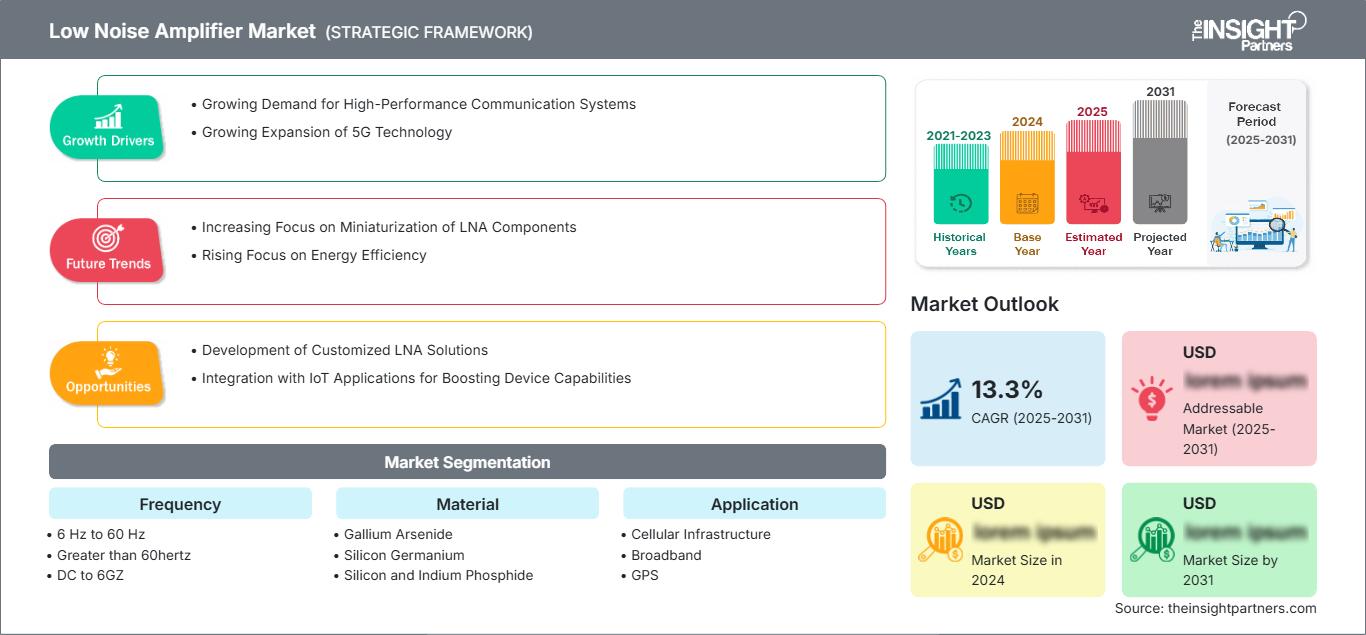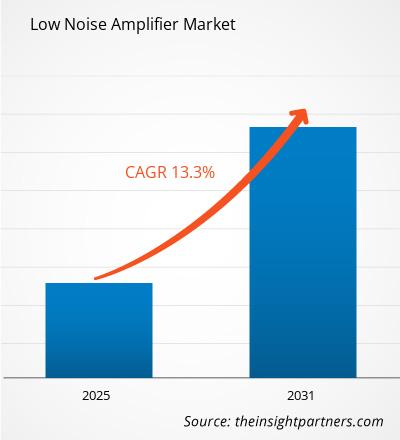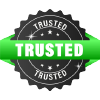The Low Noise Amplifier Market is expected to register a CAGR of 13.3% from 2025 to 2031, with a market size expanding from US$ XX million in 2024 to US$ XX Million by 2031.
Report is Segmented by Frequency (6 Hz to 60 Hz, Greater than 60hertz, DC to 6GZ), Material (Gallium Arsenide, Silicon Germanium, Silicon and Indium Phosphide), Application (Cellular Infrastructure, Broadband, GPS , ISM Band and WLAN), Vertical (Telecom and Datacom, Consumer Electronics, Military & Space, Medical, Automotive, Industrial). The global analysis is further broken-down at regional level and major countries. The report offers the value in USD for the above analysis and segments
Purpose of the Report
The report Low Noise Amplifier Market by The Insight Partners aims to describe the present landscape and future growth, top driving factors, challenges, and opportunities. This will provide insights to various business stakeholders, such as:
- Technology Providers/Manufacturers: To understand the evolving market dynamics and know the potential growth opportunities, enabling them to make informed strategic decisions.
- Investors: To conduct a comprehensive trend analysis regarding the market growth rate, market financial projections, and opportunities that exist across the value chain.
- Regulatory bodies: To regulate policies and police activities in the market with the aim of minimizing abuse, preserving investor trust and confidence, and upholding the integrity and stability of the market.
Low Noise Amplifier Market Segmentation
Frequency
- 6 Hz to 60 Hz
- Greater than 60hertz
- DC to 6GZ
Material
- Gallium Arsenide
- Silicon Germanium
- Silicon and Indium Phosphide
Application
- Cellular Infrastructure
- Broadband
- GPS
- ISM Band and WLAN
Vertical
- Telecom and Datacom
- Consumer Electronics
- Military & Space
- Medical
- Automotive
- Industrial
You will get customization on any report - free of charge - including parts of this report, or country-level analysis, Excel Data pack, as well as avail great offers and discounts for start-ups & universities
Low Noise Amplifier Market: Strategic Insights

-
Get Top Key Market Trends of this report.This FREE sample will include data analysis, ranging from market trends to estimates and forecasts.
Low Noise Amplifier Market Growth Drivers
- Growing Demand for High-Performance Communication Systems: The low noise amplifier (LNA) market is primarily driven by the increasing demand for high-performance communication systems. As the telecommunications industry continues to evolve, there is a strong need for devices that can enhance signal quality while minimizing noise. LNAs are crucial in wireless communication, satellite systems, and mobile networks, where they amplify weak signals without significantly adding noise. This demand for superior signal processing capabilities is propelling the growth of the LNA market across various applications.
- Growing Expansion of 5G Technology: The rollout of 5G technology is a significant driver for the low noise amplifier market. 5G networks require advanced components that can handle higher frequency ranges and provide better signal integrity. LNAs play an essential role in 5G infrastructure by amplifying weak signals from remote radio heads and base stations. With the global push towards 5G deployment, the demand for high-quality LNAs is expected to surge, creating a robust market environment for manufacturers to innovate and cater to these needs.
Low Noise Amplifier Market Future Trends
- Increasing Focus on Miniaturization of LNA Components: A notable trend in the low noise amplifier market is the miniaturization of components to meet the growing demands for compact devices. As electronic devices become smaller and more portable, there is a need for LNAs that occupy less space while delivering high performance. Manufacturers are focusing on developing smaller, integrated LNA solutions that can fit into tight spaces without compromising functionality. This trend towards miniaturization is particularly prominent in consumer electronics and mobile devices, where size and performance are critical.
- Rising Focus on Energy Efficiency: There is a growing trend towards energy efficiency in the design and application of low noise amplifiers. With increasing awareness regarding energy consumption and its environmental impact, manufacturers are developing LNAs that operate at lower power levels while maintaining high performance. Energy-efficient LNAs can significantly reduce the overall power consumption of communication systems, making them more sustainable. This trend aligns with global initiatives to reduce carbon footprints and is influencing the design and production of next-generation LNA solutions.
Low Noise Amplifier Market Opportunities
- Development of Customized LNA Solutions: The demand for customized low noise amplifier solutions presents significant opportunities for growth in the market. Different applications require specific performance characteristics, such as frequency range, gain, and power consumption. Manufacturers can capitalize on this opportunity by offering tailored LNA designs that meet the unique needs of various industries, including telecommunications, aerospace, and automotive. By focusing on customization, companies can differentiate themselves in a competitive market and build strong relationships with clients.
- Integration with IoT Applications for Boosting Device Capabilities: The integration of low noise amplifiers with Internet of Things (IoT) applications offers substantial opportunities for growth. IoT devices often require robust communication capabilities to transmit data effectively, and LNAs can enhance the performance of these devices by improving signal quality and range. As the IoT ecosystem continues to expand across various sectors, including smart cities, healthcare, and industrial automation, the demand for LNAs designed for IoT applications is likely to increase. This presents an excellent opportunity for manufacturers to innovate and cater to this rapidly evolving market segment.
Low Noise Amplifier Market Regional Insights
The regional trends and factors influencing the Low Noise Amplifier Market throughout the forecast period have been thoroughly explained by the analysts at The Insight Partners. This section also discusses Low Noise Amplifier Market segments and geography across North America, Europe, Asia Pacific, Middle East and Africa, and South and Central America.
Low Noise Amplifier Market Report Scope
| Report Attribute | Details |
|---|---|
| Market size in 2024 | US$ XX million |
| Market Size by 2031 | US$ XX Million |
| Global CAGR (2025 - 2031) | 13.3% |
| Historical Data | 2021-2023 |
| Forecast period | 2025-2031 |
| Segments Covered |
By Frequency
|
| Regions and Countries Covered |
North America
|
| Market leaders and key company profiles |
|
Low Noise Amplifier Market Players Density: Understanding Its Impact on Business Dynamics
The Low Noise Amplifier Market is growing rapidly, driven by increasing end-user demand due to factors such as evolving consumer preferences, technological advancements, and greater awareness of the product's benefits. As demand rises, businesses are expanding their offerings, innovating to meet consumer needs, and capitalizing on emerging trends, which further fuels market growth.

- Get the Low Noise Amplifier Market top key players overview
Key Selling Points
- Comprehensive Coverage: The report comprehensively covers the analysis of products, services, types, and end users of the Low Noise Amplifier Market, providing a holistic landscape.
- Expert Analysis: The report is compiled based on the in-depth understanding of industry experts and analysts.
- Up-to-date Information: The report assures business relevance due to its coverage of recent information and data trends.
- Customization Options: This report can be customized to cater to specific client requirements and suit the business strategies aptly.
The research report on the Low Noise Amplifier Market can, therefore, help spearhead the trail of decoding and understanding the industry scenario and growth prospects. Although there can be a few valid concerns, the overall benefits of this report tend to outweigh the disadvantages.
Frequently Asked Questions
What are the options available for the customization of this report?
What are the deliverable formats of the market report?
What are the future trends of the low noise amplifier market?
What are the driving factors impacting the global low noise amplifier market?
What is the expected CAGR of the low noise amplifier market
- Historical Analysis (2 Years), Base Year, Forecast (7 Years) with CAGR
- PEST and SWOT Analysis
- Market Size Value / Volume - Global, Regional, Country
- Industry and Competitive Landscape
- Excel Dataset
Recent Reports
Testimonials
Reason to Buy
- Informed Decision-Making
- Understanding Market Dynamics
- Competitive Analysis
- Identifying Emerging Markets
- Customer Insights
- Market Forecasts
- Risk Mitigation
- Boosting Operational Efficiency
- Strategic Planning
- Investment Justification
- Tracking Industry Innovations
- Aligning with Regulatory Trends





















 Get Free Sample For
Get Free Sample For